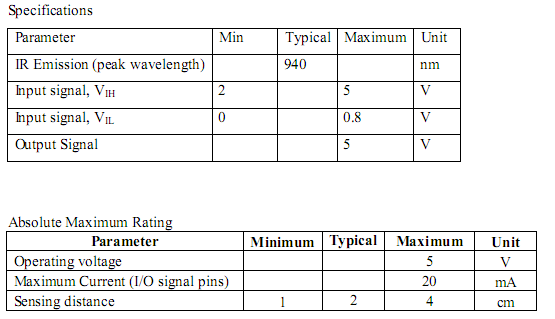Mini Wheel 46x10 mm
This custom-designed plastic wheel has a rubber tire measuring 46mm in
diameter and is designed to fit the output shafts on our SPG10 series
gearmotors as well as the Solarbotic metal gear motor.
Specification:
- Diameter : 46mm
- Width of tire: 10mm
- weight: 12g
XBee 1mW Wire Antenna
Finally user can enjoy another simple yet reliable wireless
communication for robots. XBee OEM RF module has been used in many
robotics applications world wide to offer wireless communication, point
to point and also mesh network. No more searching for surrounding
device and request for connection, it can send data wireless after
powering up without any extra configuration. Additionally, the
communication range is very good (100 meters) for a low powered device
(1mW). Its small form factor saves valuable board space. No
configuration is necessary for out-of-box RF communications. XBee
module comes with application software to ease user in editing
configuration and also for functional testing. Since the XBee module
pin is 2mm pitch to pitch (is difficult to plug in standard board), you
can use SKXBEE as starter kit.
Product Summary:
- ISM 2.4 GHz operating frequency
- 1 mW (0 dBm) power output
- Industrial temperature rating (-40° C to 85° C)
- Indoor/Urban range: up to 100 ft (30 m)
- Outdoor/RF line-of-sight range: up to 300 ft (100m)
- Interface data rate: Up to 115.2 Kbps
- Receive current: 50 mA (@ 3.3 V)
- Transmit current: 45mA (@3.3V)
- 6 10-bit ADC input pins
- 8 digital IO pins
- AT or API command set
- Power-down sleep current: <10 µA
- Supply voltage: 2.8 - 3.4V
- 2mm pitch to pitch DIP pin
Package included:
Dimension: 2.438cm x 2.761cm
XBEE STARTER KIT
XBee
has becoming extremely popular among robot builder and embedded
wireless communication. It can be use for control and monitoring, data
streaming, real time wireless update and also wireless downloader.Finally user can enjoy another simple yet reliable wireless
communication for robots. However, using XBee OEMRF module need extra
work to interface since it is 3.3V power and offer 3.3V interface. With
these reason, Cytron Technologies has designed Starter kit for user to
easily use XBee module. With SKXbee, useronly requires 4 simple wiring
to offer wireless communication to 5V microcontroller. On board USB
interface, can easily turn SKXBee into XBee dongle.
Features:
- Communication range up to 100 meters
- Soldered with XBee module and tested before being shipped
- USB Plug and Play UART function
- 5V powered
- 5V UART interface, ready for microcontroller interface
- Default baud rate of 9600bps
- Long Range Data Integrity
- Low power consumption
- Compact yet easy and reliable platform
- As serial port replacement (wireless)
- Point-to-point, point-to-multipoint and peer-to-peer topologies supported
Dimension: 8cm x 4cm
IR Sensor Set
The
IRS-01 IR sensor set consists of an IR transmitter and an IR receiver
mounted side by side on a tiny PCB. With a 5 VDC power, it can be used
as a reflective type IR sensor for mobile robot or any simple control
system.
Dimension: 1.2cm x 1cm
Sharp Analog Distance Sensor (10-80cm)
Description:
The Sharp distance sensor is a popular choice for application and
development that require accurate distance measurements. This IR sensor
is more economical than sonar range finders, yet it provides much
better performance than other IR alternatives. Interfacing to most
microcontrollers is straightforward: the single analog output can be
connected to an analog-to-digital (ADC) converter for reading distance
measurements. The output can also be connected to a comparator for
threshold detection.
Specification:
- Similar specification to GP2D12
- 4.5V to 5.5V operating voltage.
- Working distance from 10cm to 80cm.
- Analog Output
- Output voltage change over distance (2.45V - 0.45V)
- Come with Connector and Wire











































